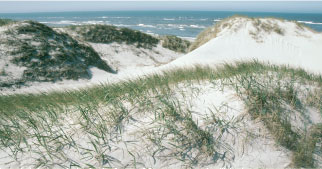Nature & Environment 2004
Introduction
Walks to the woods, the countryside, round a lake or along the beach; these are recreational activities that most of us enjoy on a regular basis without further ado. We value nature and welcome the experiences it brings us. Cost-benefit analyses show that if required to, Danes would pay up to 300 (EUR 40) for an annual license to visit the woods, and they show that house prices tend to increase considerably (by up to DKK 200,000 (EUR 26,827)) for houses situated on land bordering a forest.
However, cities, infrastructure, and agriculture have put nature under pressure. In order to compensate for this pressure and preserve a diverse and rich nature, it is important that we take care of and protect nature. Measures that contribute to this include nature restoration, financial support to environmentally friendly farming and farmers who improve their nature and landscape management.
We live in a constructed or cultivated landscape, and agriculture is responsible for three-quarters of Danish landscapes, i.e. fields, forests and natural areas. Consequently, when agriculture changes its production practices, nature and the landscape change as well. This means that the rare and richly diverse vegetation on the almost 200,000 hectares of meadows and dry grasslands is in the process of becoming overgrown by scrub. Here, efforts to safeguard plant and animal life are required.
As part of efforts to improve the protection of nature and reduce environmental pressures, leaching and runoff of nitrogen to lakes and watercourses from fields have been halved, and ammonia volatilisation has been reduced by one-third. However, more is required, if we are to arrive at the quality of nature and the environment that we desire, and if we are to live up to the EU requirements for nature and the environment set out in the Water Framework, Birds, and Habitats Directives.
Expected climate change in Denmark points to a warmer, more humid and windier climate, including more storms and prolonged periods rainfall. Man-made climate change influences virtually all the Earth's
ecosystems. The first effects documented in nature are changes in the amount and rhythm of water (runoff). Changes in precipitation and runoff will,
if they continue, have great impacts on draining in river valleys, loss and leaching of substances, and on ecological conditions in watercourses, lakes, and fjords. Furthermore, a spread of plant species from
southern into northern Europe due to the rise in temperatures has been observed, putting further pressure on the function of ecosystems and valuable natural assets.
Many sectors of society are involved in shaping the Danish landscape, and many interests conflict when the use of land and nature for different purposes have to be prioritised. Land is a scarce resource in Denmark, but by duly considering e.g. the quality of our landscapes, the condition and function of ecosystems and the need for biological diversity, we can make our production and consumption practices friendly toward nature and the environment, and thus be able to leave the Earth in as good a state as we received it. It is also a prerequisite that we limit the global emissions of greenhouse gases in order to prevent the consequences they pose to nature through changes in the climate.
Public commitment to sustainable management and protection of nature is crucial if we are to reach the results desired. Education and communication, as well as better opportunities for good nature experiences and outdoor recreation, are paramount if we are to make the often very complicated interrelationships in nature commonly known and appreciated.
This year, the indicator report evolves around the theme ”protection of Danish nature”. The theme booklet illustrates e.g. trends in selected species, the area of valuable, Danish natural areas, the most dire threats to nature, etc. Furthermore, in the form of overviews the theme booklet describes the measures which the Ministry of the Environment is setting in motion in order to protect nature. The theme is described through 18 selected indicators. The overall set of indicators, comprising about 70 indicators for nature and the environment, can be viewed on the Internet.

Collaboration on nature protection in the EU
The Birds and Habitats Directives
The Birds and Habitats Directives contain 2 main principles for the protection of nature in Europe:
- Member States must designate, protect, and manage special protection areas that contain species and habitats which at European level have been agreed upon as worthy of protection.
- Member States must protect specified species against collection, extinction, exploitation, etc., as well as protect their breeding sites and resting places from damage and destruction.
Denmark has designated a total of 254 habitat areas and 113 bird protection areas, on land and at sea.
Natura 2000
NATURA 2000 is a generic term for bird protection areas and habitat areas.
The EU Water Framework Directive
The EU Water Framework Directive, which entered into force on 22 December 2000, lays down a new framework for protection of the aquatic environment. In December 2003, the Danish Parliament adopted a new Environmental Targets Act, implementing the Directive in Danish legislation. The objective of the Water Framework Directive is to ensure the protection of watercourses, lakes, transition waters, coastal waters, and groundwater.
Source: Danish Forest and Nature Agency, Danish EPA
Version 1.0 December 2005, © Danish Environmental Protection Agency